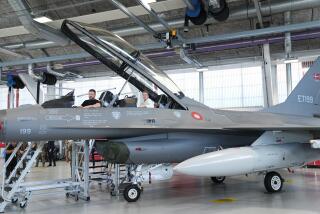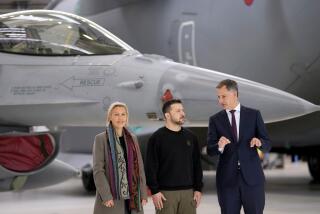F-22 Jet in Dogfight at Pentagon
EDWARDS AIR FORCE BASE â Under the blistering desert sun, in a hangar surrounded by barbed-wire-topped fences and electronic security gates, dozens of mechanics bustle around an F-22 Raptor, the most deadly fighter ever built.
The Air Force says the F-22 can do things no fighter has ever done--flying faster and farther than any rival, and all with gymnastic maneuverability. But right now, the aircraftâs fight isnât in the skies over Bosnia or in a dogfight with Iraqi MIGs--it is in the corridors of the Pentagon.
On Tuesday, exactly a decade after Lockheed Martin Co. won the F-22 contract, a Pentagon panel is scheduled to review the jetâs test performance and consider whether to launch a limited initial production of what is expected to be the most expensive fighter ever. If the matter is not approved, production will be delayed at least another year, when officials will take up the issue again.
The oft-delayed decision will come as critics have stepped up efforts to curtail the $58-billion program, saying the plane is too expensive and is no longer needed in the post-Cold War era.
Critics want the Air Force to cut F-22 purchases and instead buy newer models of the F-15, saying it would be less expensive. They note that the F-15 never lost a battle in more than 100 engagements. F-15s downed four MIG-29 fighters during the Balkan conflict and 33 of the 35 Iraqi aircraft shot down during Operation Desert Storm.
Each F-22 is expected to cost $84 million, but adding in research and development, maintenance, facilities and related support expenses, that figure swells to about $173 million, federal officials say.
âThe F-22 is a continuation of the flawed weapons-buying system that allows overpriced, under-tested weapons to dominate our military policy,â said Danielle Brian, executive director of the Project on Government Oversight, a Washington-based government watchdog group. âAs long as the Pentagon continues this trend, defense contractors will benefit at the expense of the military and taxpayers.â
The Air Force and its supporters say production of the Raptor is essential if the U.S. is to maintain its military dominance of the skies. The Air Force wants 339 F-22s to replace the venerable F-15, an air-to-air fighter that was developed in the late 1960s.
âIt would be crazy to further cut and delay this program,â said Loren Thompson, a defense analyst at the Lexington Institute, a conservative military policy think tank in Arlington, Va. âIf the point is that we donât have a peer competitor today, theyâre right. But if their point is that they know what weâll face 10 to 20 years from now, theyâre wrong. History has taught us that one way or another, there always is going to be a potential threat.â
Although the F-22 will be assembled in Marietta, Ga., the stakes are huge for the Southern California economy, particularly for about 250 aerospace contractors scattered throughout the region who make up a large share of the work on the F-22.
The value of the contract to Southland suppliers--from Raytheon Corp. in El Segundo, where engineers developed the main computer for the airplane, to BAE Systemsâ electronics group in Santa Monica--could surpass $11 billion, Lockheed said.
In Orange County, local orders for work on F-22 components, led by 5,000-employee Parker Aerospace in Irvine, already exceed $1 billion. Parker makes various elements of the jetâs fuel, flight control and fluid systems.
Planeâs Technology Is Revolutionary
Despite debate over the cost and its relevance, test versions of the F-22 are meeting and in some cases exceeding expectations, according to assessments by the General Accounting Office and Air Force test pilots.
The F-22, in development since 1991 and expected to be deployed in late 2005, will be the most advanced fighter in the world. With engines that have thrust-vectoring nozzles that can move up and down, the Raptor can fire missiles while flying with its nose at a 60-degree angle.
The Raptor also can reach supersonic speed without using fuel-guzzling afterburners, a revolutionary feature that allows the F-22 to fly faster and farther. Afterburners are expensive to operate because they inject additional fuel into hot exhaust gases.
Moreover, new radars and sensors installed on the plane enable the pilot to track, identify and shoot an aircraft before the enemy pilot can detect the F-22.
For Lt. Col. David âDocâ Nelson, who has flown the F-15 for 20 years, all the advanced features canât compare to the one that is prized most: the Raptorâs ability to evade radar.
âItâs invisible. Thatâs the coolest,â said Nelson, who also is a test pilot for the F-22. âWe can sneak up on the enemy plane and shoot it down without the pilot ever seeing us.â
âWe donât want a fair fight. We want to win decisively,â added Col. Chris Seat, a native of Santa Ana and another F-22 test pilot.
Despite the praise, the F-22 has been rife with controversy from the day in 1991 when Lockheed beat out Northrop Grumman Corp.âs proposed YF-23 in a competition to create the Air Forceâs 21st century fighter jet. The competition to develop a replacement for the F-15 began in the early 1980s. The F-22 was designed at the Lockheed Skunkworks facility in Burbank. Defense analysts said recent reports that the program could eventually be $2 billion to $9 billion over cost could weigh heavily when the Pentagonâs Defense Acquisitions Board meets to consider starting low-rate production of 10 F-22s at a cost of $2.1 billion.
Congress capped the overall program cost at $58 billion; any cost overruns could result in the acquisition of fewer aircraft.
Robert Rearden, Lockheedâs program manager for the F-22, said there is no cost overrun in the program currently because the company is slated to deliver the Raptor under a fixed-cost contract. The Pentagon typically orders a block of airplanes annually before signing multiyear contracts. The projections of cost overruns are based on whatâs âgoing to happen over the next 13 years,â he said.
âThere just isnât enough hard data to make that estimate,â Rearden said. âWeâll have enough data two or three years after we start delivery. Thatâs when youâll know what the true cost of the program will be.â
The Air Force first tried to get the go-ahead two years ago. But delays in the flight-test program, coupled with critical cost reviews, caused Congress and then-Defense Secretary Donald H. Rumsfeld to postpone the decision.
F-22 supporters fear that any further delays or moves to slash the number of jets purchased could lead to a similar fate as that faced by the B-2 stealth bomber, whose price tag rose significantly after former President Bush slashed production from an initial target of 135 to 20 in 1992. President Clinton later approved building one more bomber. Reducing the production rate adds significantly to the cost because the craft cannot be produced as efficiently.
Program Tugging at the Purse Strings
The F-22 seemed to follow a similar path. The Pentagon initially wanted 750 planes at about $35 million each when it was first proposed in 1985, but it was slashed to 648 planes in 1991, to 438 in 1993 and then to 339 in 1999, raising the per-plane cost to $84 million.
But Lockheed executives contend that the Raptor is not that much more expensive than the F-15E, the newest model of the F-15 that has a price tag of about $70 million.
âYouâre paying more than 80% of the money that you could [spend on] an F-22 to buy a 30-year-old technology without the capabilities of the F-22,â said Greg Caires, a Lockheed spokesman.
(BEGIN TEXT OF INFOBOX / INFOGRAPHIC)
The F-22 Raptor
In development since the early 1980s, the F-22 Raptor is intended to replace the
F-15 Eagle as the Air Forceâs premier fighter. The Raptor will improve on existing fighters with its balance of stealth, fuel-efficient supersonic flight, increased range and enhanced offensive and defensive avionics. At a cost of $173 million per jet (including research, development and support, the Raptor would be the most expensive fighter ever built.
*
Advanced Radar Capability
The F-22âs radar will provide pilots with detailed information about multiple threats before it is detected by enemy radar. This âbeyond visual rangeâ capability will allow an F-22 pilot in air-to-air combat to track, target and shoot at multiple enemy aircraft while remaining invisible.
*
How the F-22 Compares With the F-15C
F-22 Raptor
* Manufacturer: Lockheed Martin
* Maximum gross weight: Classified
* Speed: Mach 2+ (maximum is classified)
* Range: Classified
* Weapons: M-61 20-mm cannon with 480 rounds of ammunition, AIM-120 AMRAAM and JDAM missiles.
* Crew: One
* Production: 339 planned
* Status: Undergoing testing
* Deployment: 2005
*
F-15C Eagle
* Manufacturer: McDonnell Douglas
* Maximum takeoff weight: 68,000 pounds
* Maximum speed: Mach 2.5+
* Range: 2,500-plus miles
* Weapons: Four AIM-9L/M Sidewinders, four AIM-7F/M Sparrow or eight AIM-120 AMRAAM and a 20-mm six-barrel cannon with 940 rounds of ammunition
* Crew: One
* Air Force fleet: 400
* First flight: 1979
*
Sources: U.S. Air Force, Federation of American Scientists, Janeâs All the Worldâs Aircraft, f-22raptor.com, lmasc.com
Researched by JULIE SHEER / Los Angeles Times
More to Read
Sign up for Essential California
The most important California stories and recommendations in your inbox every morning.
You may occasionally receive promotional content from the Los Angeles Times.










